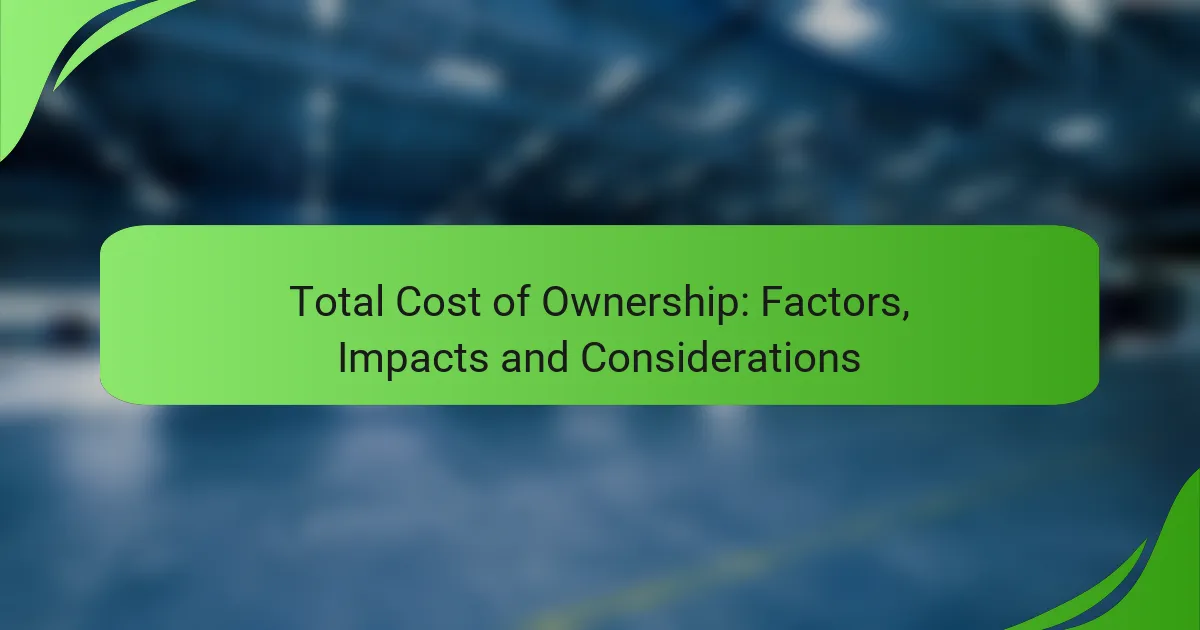Total Cost of Ownership (TCO) is a crucial concept that encompasses all costs associated with acquiring and operating an asset throughout its lifecycle. By evaluating factors such as initial purchase price, maintenance expenses, and operational costs, individuals and businesses can make more informed financial decisions. A thorough understanding of TCO not only aids in budgeting but also aligns investments with long-term goals and strategies.

What factors influence Total Cost of Ownership in the automotive industry?
The Total Cost of Ownership (TCO) in the automotive industry is influenced by several key factors, including the initial purchase price, fuel efficiency, maintenance costs, insurance premiums, and depreciation rates. Understanding these elements helps consumers make informed decisions about vehicle investments.
Initial purchase price
The initial purchase price is the upfront cost of acquiring a vehicle and is often the most significant factor in TCO. This price can vary widely based on the make, model, and features of the vehicle. Buyers should consider not only the sticker price but also potential financing options and incentives that can affect overall affordability.
When evaluating the initial purchase price, it’s essential to compare similar vehicles within the same category. For instance, a compact car may cost significantly less than a luxury SUV, but the long-term costs associated with each can differ greatly.
Fuel efficiency
Fuel efficiency directly impacts the ongoing costs of operating a vehicle. Vehicles that consume less fuel will generally result in lower expenses over time, especially with fluctuating fuel prices. For example, a car that averages 30 miles per gallon will cost less to fuel than one that averages 20 miles per gallon, assuming similar driving conditions.
To assess fuel efficiency, consider the vehicle’s miles per gallon (MPG) ratings and how they align with your driving habits. For urban driving, a hybrid or electric vehicle may offer significant savings compared to traditional gasoline engines.
Maintenance costs
Maintenance costs encompass routine services, repairs, and parts replacement throughout the vehicle’s lifespan. These costs can vary based on the vehicle’s make and model, with luxury brands often requiring more expensive parts and specialized service. Regular maintenance, such as oil changes and tire rotations, is crucial for prolonging a vehicle’s life and minimizing unexpected repairs.
It’s advisable to research the average maintenance costs for specific models before purchase. Some manufacturers offer extended warranties or maintenance packages that can help mitigate these expenses over time.
Insurance premiums
Insurance premiums are another critical component of TCO, as they can vary significantly based on the vehicle type, driver profile, and location. Generally, newer or more expensive vehicles tend to have higher insurance rates. Factors such as safety ratings and theft rates can also influence premiums.
To manage insurance costs, shop around for quotes from multiple providers and consider factors like deductibles and coverage levels. Opting for vehicles with higher safety ratings can lead to lower premiums, making them a more economical choice in the long run.
Depreciation rates
Depreciation refers to the decline in a vehicle’s value over time and is a crucial factor in TCO. Typically, new cars lose a significant portion of their value within the first few years, with some models depreciating faster than others. Understanding a vehicle’s depreciation rate can help buyers make smarter investment choices.
To minimize the impact of depreciation, consider purchasing used vehicles that have already experienced the most significant value drop. Additionally, certain brands and models tend to hold their value better than others, making them more attractive options for long-term ownership.
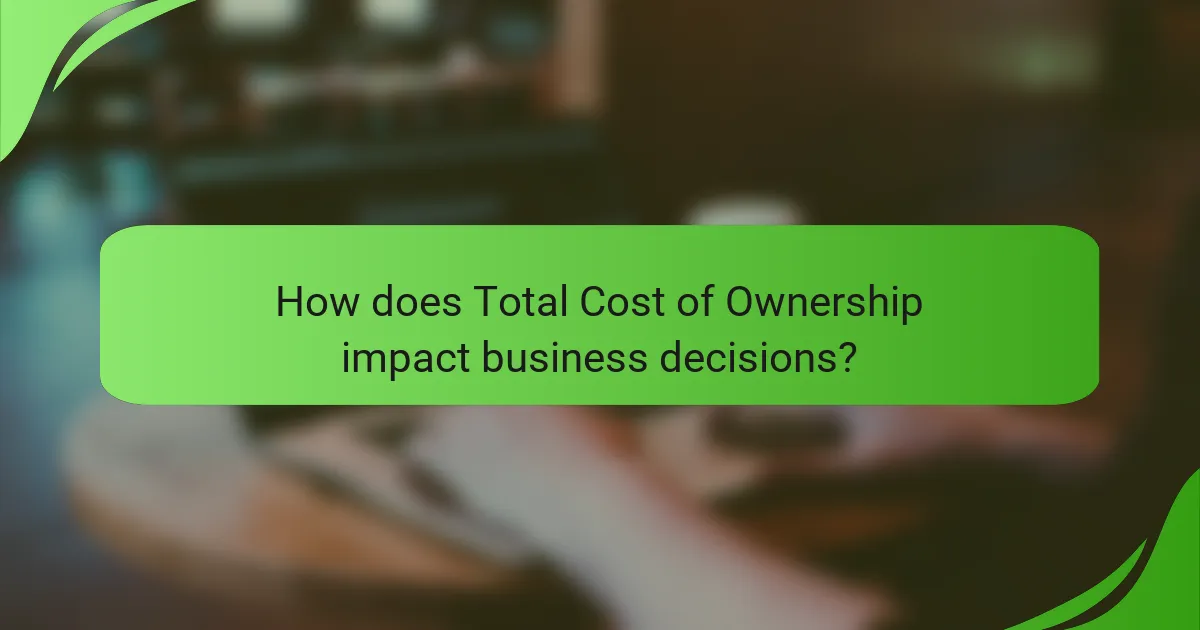
How does Total Cost of Ownership impact business decisions?
Total Cost of Ownership (TCO) significantly influences business decisions by providing a comprehensive view of the costs associated with acquiring and operating an asset over its entire lifecycle. Understanding TCO helps businesses make informed choices that align with their financial goals and operational strategies.
Budget allocation
Effective budget allocation requires a clear understanding of TCO, as it encompasses not only the initial purchase price but also ongoing operational costs, maintenance, and potential disposal fees. Businesses should analyze TCO to ensure that funds are allocated efficiently across various departments and projects.
For instance, when considering new technology, a company might find that a higher upfront cost could lead to lower long-term expenses due to reduced maintenance and energy consumption. This insight can guide budget decisions that prioritize long-term savings over short-term expenditures.
Long-term financial planning
Incorporating TCO into long-term financial planning allows businesses to forecast expenses more accurately and allocate resources effectively. By understanding the full cost implications of assets, companies can develop strategies that align with their financial objectives and risk tolerance.
For example, a business might choose to invest in energy-efficient equipment that has a higher initial cost but results in significant savings on utility bills over time. This approach not only improves cash flow but also supports sustainability initiatives, enhancing the company’s reputation and compliance with environmental regulations.
Asset management strategies
Asset management strategies benefit from TCO analysis by identifying the total costs associated with maintaining and operating assets throughout their lifecycle. This holistic view enables businesses to make strategic decisions about asset acquisition, utilization, and disposal.
Companies should regularly review their assets’ TCO to determine whether to upgrade, maintain, or replace them. For instance, if the TCO of an aging piece of equipment exceeds the cost of a new, more efficient model, it may be prudent to invest in new technology to optimize operations and reduce long-term expenses.
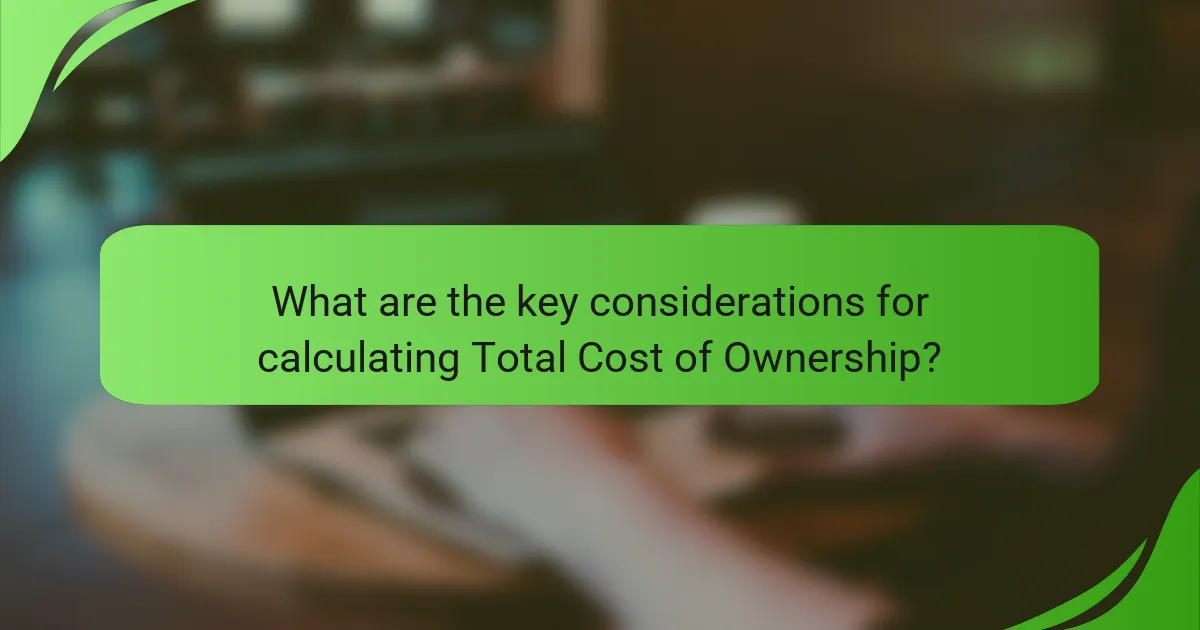
What are the key considerations for calculating Total Cost of Ownership?
Calculating Total Cost of Ownership (TCO) involves assessing all costs associated with a product or service over its entire lifecycle. Key considerations include both direct and indirect costs, as well as a thorough lifecycle analysis to ensure comprehensive understanding and informed decision-making.
Direct costs
Direct costs are the expenses that can be directly attributed to the acquisition and operation of a product or service. These typically include purchase price, installation fees, and maintenance costs. For instance, when purchasing machinery, the initial cost plus any setup fees would be considered direct costs.
In addition to the upfront expenses, ongoing operational costs such as utilities and labor directly related to the product should also be factored in. Understanding these costs helps in making accurate comparisons between different options.
Indirect costs
Indirect costs are less obvious but equally important in the TCO calculation. These may include overhead expenses, training costs, and potential downtime during implementation. For example, if a new software system requires extensive employee training, those costs should be included in the TCO analysis.
Additionally, consider the impact of indirect costs on productivity and efficiency. A product that appears cheaper upfront may lead to higher indirect costs if it requires frequent maintenance or causes workflow disruptions.
Lifecycle analysis
Lifecycle analysis evaluates the total costs associated with a product from acquisition through disposal. This includes not only the purchase and operational costs but also end-of-life disposal or recycling expenses. For example, a vehicle’s TCO would encompass fuel, insurance, maintenance, and eventual resale value.
Conducting a lifecycle analysis allows businesses to make more sustainable and economically sound decisions. It is essential to consider how long the product will last and its efficiency over time to accurately assess its total cost. Utilizing tools or software designed for TCO analysis can streamline this process and provide clearer insights.
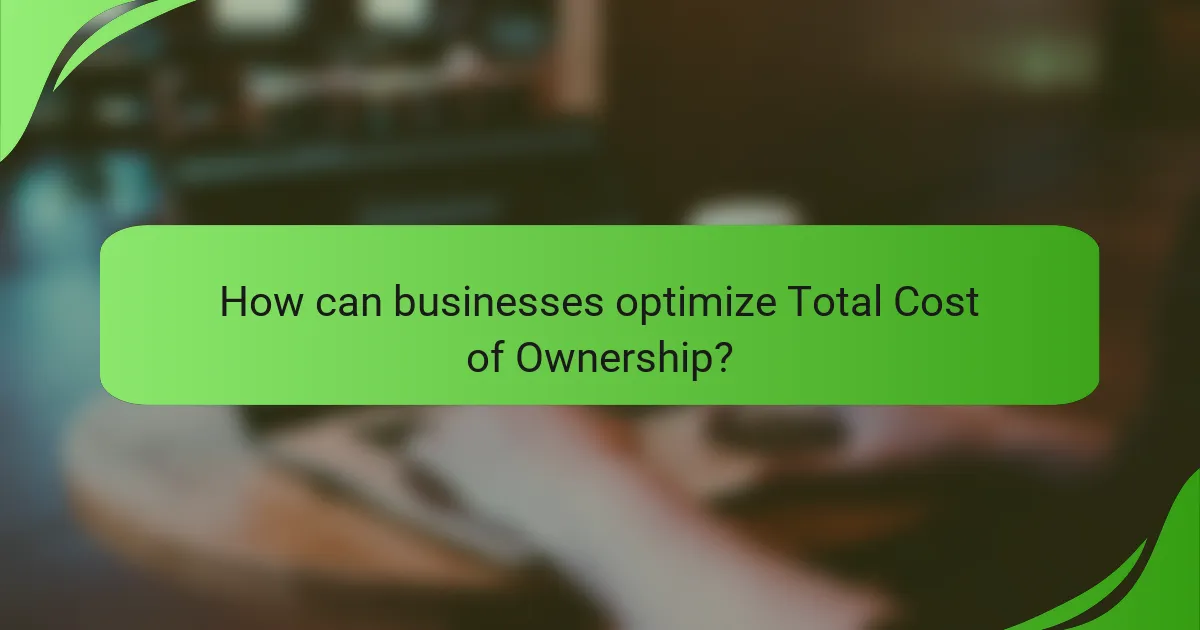
How can businesses optimize Total Cost of Ownership?
Businesses can optimize Total Cost of Ownership (TCO) by focusing on key factors such as maintenance, fuel efficiency, and technology integration. By strategically managing these areas, companies can reduce long-term expenses and improve overall operational efficiency.
Regular maintenance schedules
Implementing regular maintenance schedules is crucial for minimizing TCO. Consistent upkeep can prevent costly repairs and extend the lifespan of assets, whether they are vehicles, machinery, or IT equipment. Businesses should consider setting reminders or using software to track maintenance tasks.
For example, a fleet of vehicles may benefit from routine oil changes and tire rotations every 5,000 to 7,500 miles. This proactive approach can save companies significant amounts in unexpected breakdown costs and downtime.
Fuel-efficient models
Choosing fuel-efficient models is another effective way to lower TCO. Vehicles or machinery that consume less fuel can drastically reduce operating costs over time. Businesses should evaluate options based on fuel economy ratings and total cost of ownership calculations.
For instance, a company might compare two delivery trucks: one with an average of 15 miles per gallon and another at 25 miles per gallon. Over several years and thousands of miles, the savings on fuel can add up to thousands of dollars, making the more efficient model a better investment.
Technology integration
Integrating technology can streamline operations and reduce TCO. Automation tools, data analytics, and management software can enhance efficiency, reduce labor costs, and improve decision-making. Businesses should assess their current processes and identify areas where technology can provide significant benefits.
For example, using a fleet management system can optimize routes, monitor fuel usage, and track maintenance schedules, leading to lower costs and improved service delivery. Investing in such technology often pays off in the long run through increased productivity and reduced operational expenses.
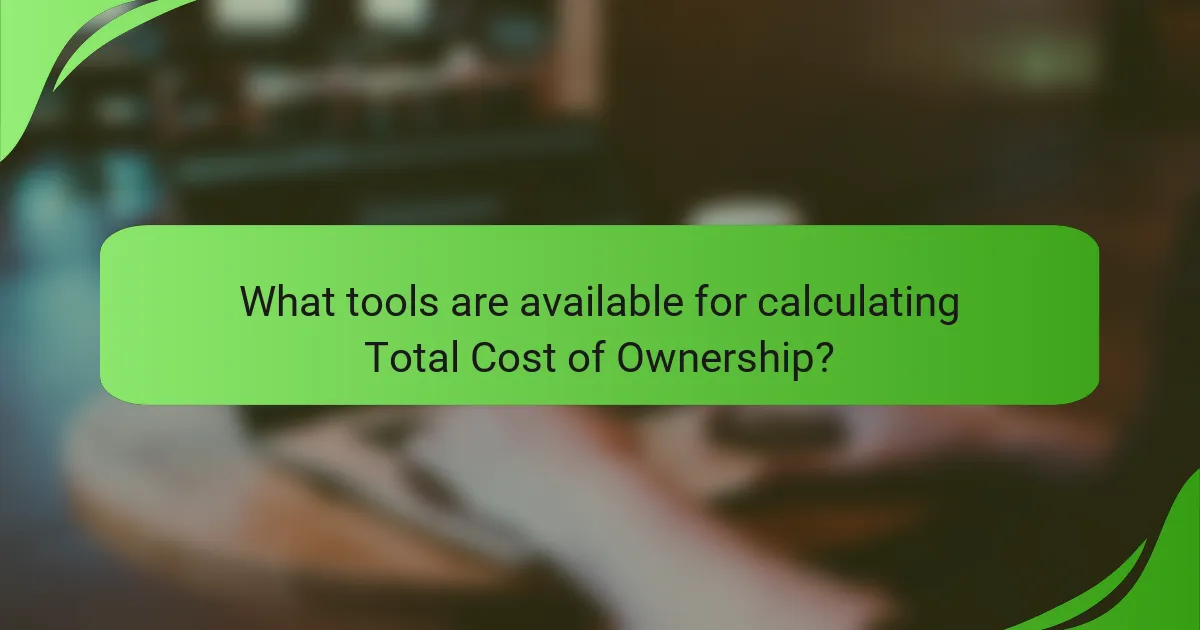
What tools are available for calculating Total Cost of Ownership?
Various tools exist for calculating Total Cost of Ownership (TCO), including online calculators and dedicated software solutions. These tools help businesses estimate the comprehensive costs associated with acquiring and maintaining assets over their lifecycle.
Online calculators
Online calculators are user-friendly tools that allow users to input specific data points related to their assets, such as purchase price, maintenance costs, and operational expenses. These calculators typically provide a quick estimate of TCO based on the information entered.
Many online calculators are free and can be found on financial or industry-specific websites. When using these tools, ensure that you have accurate data to achieve a reliable estimate, and be aware that results may vary based on the assumptions built into the calculator.
Software solutions
Software solutions for calculating TCO offer more advanced features than online calculators, including detailed reporting, scenario analysis, and integration with other financial systems. These tools are often used by larger organizations that require comprehensive data management and analysis capabilities.
When selecting a software solution, consider factors such as cost, ease of use, and the specific features that meet your organization’s needs. Some popular options may include enterprise resource planning (ERP) systems or dedicated financial analysis software that can provide deeper insights into TCO over time.
